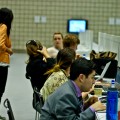Lost at COP
Mim DiNapoli | November 13, 2013.
Forget plenary halls and meeting rooms — or even Room Lublin and Katowicke. Here’s The Verb’s guide to the actual rooms of any UNFCCC meeting.
1. Cloak room: Who knows what’s concealed in the pockets of a suave diplomat – is it a hotel keycard, gum or a non-functioning mobile phone? Pencilled working papers in a breast pocket? Is COP hosting a Mr Bond?
2. Hallway: You trip over something on the way to lunch. Is it a bag? Is it a dog? No, it’s just another barefoot breakaway from an NGO-delegate napping in the hallway. Carpets are particularly susceptible to this growing phenomenon. Bonus if there are ledges for head rests.
3. Bathroom: Passing toilet rolls to a head delegate, sharing a hand-dryer with the Secretariat… The possibilities for exchange of opinions, business cards and hand soap are endless. Although you’ll do well to remember: what happens in public bathrooms rarely stays there.
4. Food court: Food unites. Plus, unwieldy dinner trays make it that much easier to corner someone over their chicken salad sandwiches and grab that selfie with your favourite climate hero. As for the menu itself, there are always the glances of sympathy over plates full of potatoes, cooked three different ways. #vegolife
5: NGO quarters and exhibition stands: Home to those NGO delegates not sleeping on the floor or fighting over a power socket. In fact, they’re often flying ‘urgent’ press releases off the printers, despite there being a whole wing for every media journalist.
6. Media centre: Otherwise known as home to the big cameras and even brighter lights. It’s where journalists go to work and hide isolated from all the action. If there’s an opinion to be had, you’ll find someone telling the Internet about it here. Oh, and the Internet there is better.
7. Coffee stands: Where the caffeine dependants flock for their hourly fix. Pay attention now or some suit running on empty might cut in front of you for his double espresso. It’s a cutthroat world.
Welcome to the UNFCCC.
By Mim DiNapoli.











comment